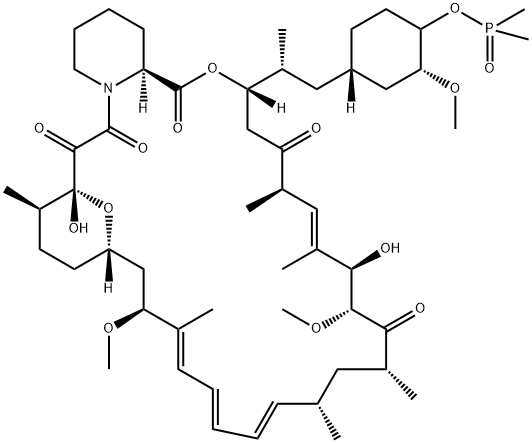42-(Dimethylphosphinate)rapamycin

|
- ₹0
- Product name: 42-(Dimethylphosphinate)rapamycin
- CAS: 572924-54-0
- MF: C53H84NO14P
- MW: 990.21
- EINECS:
- MDL Number:
- Synonyms:RidaforoliMus, >80%;DeforoliMus(AP 23573,MK-8669,RidaforoliMus);DeforoliMus (RidaforoliMus);RidaforoliMus (DeforoliMus, MK-8669);DeforoliMus API;DeforoliMus(MK-8669);RapaMycin 42-(DiMethylphosphinate);AP 23573, MK 8669, 42-DiMethylphosphinate-rapaMycin
| Manufacturer | Product number | Product description | Packaging | Price | Updated | Buy |
|---|
Properties
Melting point :95-98°C
Boiling point :996.2±75.0 °C(Predicted)
Density :1.18±0.1 g/cm3(Predicted)
storage temp. :Hygroscopic, -20°C Freezer, Under Inert Atmosphere
solubility :DMSO (Slightly), Methanol (Slightly)
form :Solid
pka :10.40±0.70(Predicted)
color :Off-White to Pale Yellow
Stability :Hygroscopic
Boiling point :996.2±75.0 °C(Predicted)
Density :1.18±0.1 g/cm3(Predicted)
storage temp. :Hygroscopic, -20°C Freezer, Under Inert Atmosphere
solubility :DMSO (Slightly), Methanol (Slightly)
form :Solid
pka :10.40±0.70(Predicted)
color :Off-White to Pale Yellow
Stability :Hygroscopic
Safety Information
| Symbol(GHS): |
 
|
|||||||||||||||||||||
|---|---|---|---|---|---|---|---|---|---|---|---|---|---|---|---|---|---|---|---|---|---|---|
| Signal word: | Warning | |||||||||||||||||||||
| Hazard statements: |
|
|||||||||||||||||||||
| Precautionary statements: |
|
Description
Ridaforolimus (Deforolimus, AP23573, MK-8669) is a selective FRAP (mTOR) inhibitor (IC50 of 0.2 nM). Ridaforolimus used to treat HT-1080 cells induces a dose-dependent inhibition of both S6 and 4E-BP1 phosphorylation, with IC50 of 0.2 nM and 5.6 nM, respectively, and leads to a decrease in cell size, an increase in the proportion of cells in the G1 phase of the cell cycle, and inhibition of glucose uptake. Ridaforolimus shows antiproliferative activity a variety of cell lines with EC50 of 0.2-2.3 nM. Ridaforolimus is a potent and selective inhibitor of VEGF production in a dose-dependent manner. Ridaforolimus treatment causes growth suppression in human NSCLC cell lines with IC30 values of 2.45-8.83 nM, with the exception of H157 with IC30 of >20 nM. Ridaforolimus treatment causes dephosphorylation of p70S6KThr389 in A549, H1703 and H157 cells, except H1666 that may express a resistant variant of mTORC1, and causes increased phosphorylation of pAKTser473 and pAKTThr308 in A549 and H1703 cells. Ridaforolimus, when combined with the MEK inhibitors CI-1040 or PD0325901, exhibits dose-dependent synergism in lung cancer cell lines, which is associated with the suppression of proliferation rather than enhancement of cell death, involving the inhibition of ribosomal biogenesis by 40% within 24 hours and a decreased polysome/monosome ratio.More related product prices
Rapamycin 252917-06-9 871700-17-3 MK-2206 2HCl Axitinib Bortezomib Mycophenolic acidRelated product price
- Rapamycin
₹4194-370089 - 252917-06-9
₹8000-47230.5 - Axitinib
₹12849.28






